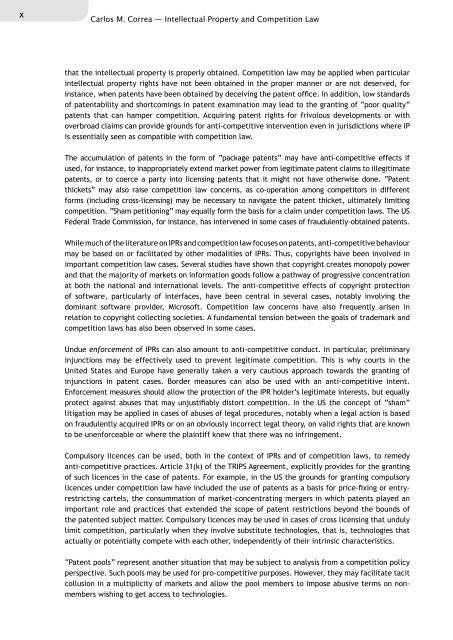Intellectual Property and Competition Law - IPRsonline.org
Intellectual Property and Competition Law - IPRsonline.org
Intellectual Property and Competition Law - IPRsonline.org
You also want an ePaper? Increase the reach of your titles
YUMPU automatically turns print PDFs into web optimized ePapers that Google loves.
Carlos M. Correa — <strong>Intellectual</strong> <strong>Property</strong> <strong>and</strong> <strong>Competition</strong> <strong>Law</strong>that the intellectual property is properly obtained. <strong>Competition</strong> law may be applied when particularintellectual property rights have not been obtained in the proper manner or are not deserved, forinstance, when patents have been obtained by deceiving the patent office. In addition, low st<strong>and</strong>ardsof patentability <strong>and</strong> shortcomings in patent examination may lead to the granting of “poor quality”patents that can hamper competition. Acquiring patent rights for frivolous developments or withoverbroad claims can provide grounds for anti-competitive intervention even in jurisdictions where IPis essentially seen as compatible with competition law.The accumulation of patents in the form of “package patents” may have anti-competitive effects ifused, for instance, to inappropriately extend market power from legitimate patent claims to illegitimatepatents, or to coerce a party into licensing patents that it might not have otherwise done. “Patentthickets” may also raise competition law concerns, as co-operation among competitors in differentforms (including cross-licensing) may be necessary to navigate the patent thicket, ultimately limitingcompetition. “Sham petitioning” may equally form the basis for a claim under competition laws. The USFederal Trade Commission, for instance, has intervened in some cases of fraudulently-obtained patents.While much of the literature on IPRs <strong>and</strong> competition law focuses on patents, anti-competitive behaviourmay be based on or facilitated by other modalities of IPRs. Thus, copyrights have been involved inimportant competition law cases. Several studies have shown that copyright creates monopoly power<strong>and</strong> that the majority of markets on information goods follow a pathway of progressive concentrationat both the national <strong>and</strong> international levels. The anti-competitive effects of copyright protectionof software, particularly of interfaces, have been central in several cases, notably involving thedominant software provider, Microsoft. <strong>Competition</strong> law concerns have also frequently arisen inrelation to copyright collecting societies. A fundamental tension between the goals of trademark <strong>and</strong>competition laws has also been observed in some cases.Undue enforcement of IPRs can also amount to anti-competitive conduct. In particular, preliminaryinjunctions may be effectively used to prevent legitimate competition. This is why courts in theUnited States <strong>and</strong> Europe have generally taken a very cautious approach towards the granting ofinjunctions in patent cases. Border measures can also be used with an anti-competitive intent.Enforcement measures should allow the protection of the IPR holder’s legitimate interests, but equallyprotect against abuses that may unjustifiably distort competition. In the US the concept of “sham”litigation may be applied in cases of abuses of legal procedures, notably when a legal action is basedon fraudulently acquired IPRs or on an obviously incorrect legal theory, on valid rights that are knownto be unenforceable or where the plaintiff knew that there was no infringement.Compulsory licences can be used, both in the context of IPRs <strong>and</strong> of competition laws, to remedyanti-competitive practices. Article 31(k) of the TRIPS Agreement, explicitly provides for the grantingof such licences in the case of patents. For example, in the US the grounds for granting compulsorylicences under competition law have included the use of patents as a basis for price-fixing or entryrestrictingcartels, the consummation of market-concentrating mergers in which patents played animportant role <strong>and</strong> practices that extended the scope of patent restrictions beyond the bounds ofthe patented subject matter. Compulsory licences may be used in cases of cross licensing that undulylimit competition, particularly when they involve substitute technologies, that is, technologies thatactually or potentially compete with each other, independently of their intrinsic characteristics.“Patent pools” represent another situation that may be subject to analysis from a competition policyperspective. Such pools may be used for pro-competitive purposes. However, they may facilitate tacitcollusion in a multiplicity of markets <strong>and</strong> allow the pool members to impose abusive terms on nonmemberswishing to get access to technologies.









